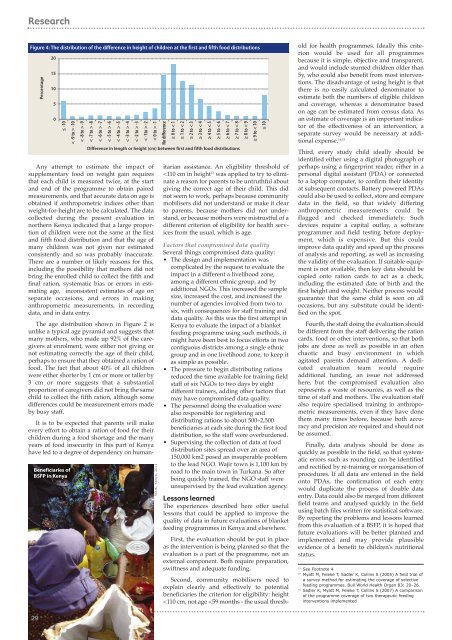Download a PDF of this issue - Field Exchange - Emergency ...
Download a PDF of this issue - Field Exchange - Emergency ...
Download a PDF of this issue - Field Exchange - Emergency ...
You also want an ePaper? Increase the reach of your titles
YUMPU automatically turns print PDFs into web optimized ePapers that Google loves.
Research<br />
Figure 4: The distribution <strong>of</strong> the difference in height <strong>of</strong> children at the first and fifth food distributions<br />
Percentage<br />
20<br />
15<br />
10<br />
5<br />
0<br />
≤ -10<br />
< -9 to > -10<br />
< -8 to > -9<br />
< -7 to > -8<br />
< -6 to > -7<br />
< -5 to > -6<br />
< -4 to > -5<br />
< -3 to > -4<br />
< -2 to > -3<br />
< -1to > -2<br />
< 0 to > -1<br />
No difference<br />
≥ 0 to < 1<br />
≥ 1 to < 2<br />
≥ 2 to < 3<br />
≥ 3 to < 4<br />
≥ 4 to < 5<br />
≥ 5 to < 6<br />
≥ 6 to < 7<br />
≥ 7 to < 8<br />
≥ 8 to < 9<br />
≥ 9 to < 10<br />
≤ 10<br />
Difference in length or height (cm) between first and fifth food distributions<br />
Any attempt to estimate the impact <strong>of</strong><br />
supplementary food on weight gain requires<br />
that each child is measured twice, at the start<br />
and end <strong>of</strong> the programme to obtain paired<br />
measurements, and that accurate data on age is<br />
obtained if anthropometric indices other than<br />
weight-for-height are to be calculated. The data<br />
collected during the present evaluation in<br />
northern Kenya indicated that a large proportion<br />
<strong>of</strong> children were not the same at the first<br />
and fifth food distribution and that the age <strong>of</strong><br />
many children was not given nor estimated<br />
consistently and so was probably inaccurate.<br />
There are a number <strong>of</strong> likely reasons for <strong>this</strong>,<br />
including the possibility that mothers did not<br />
bring the enrolled child to collect the fifth and<br />
final ration, systematic bias or errors in estimating<br />
age, inconsistent estimates <strong>of</strong> age on<br />
separate occasions, and errors in making<br />
anthropometric measurements, in recording<br />
data, and in data entry.<br />
The age distribution shown in Figure 2 is<br />
unlike a typical age pyramid and suggests that<br />
many mothers, who made up 92% <strong>of</strong> the caregivers<br />
at enrolment, were either not giving or<br />
not estimating correctly the age <strong>of</strong> their child,<br />
perhaps to ensure that they obtained a ration <strong>of</strong><br />
food. The fact that about 40% <strong>of</strong> all children<br />
were either shorter by 1 cm or more or taller by<br />
3 cm or more suggests that a substantial<br />
proportion <strong>of</strong> caregivers did not bring the same<br />
child to collect the fifth ration, although some<br />
differences could be measurement errors made<br />
by busy staff.<br />
Beneficiaries <strong>of</strong><br />
BSFP in Kenya<br />
SCUK, Kenya, 2011<br />
It is to be expected that parents will make<br />
every effort to obtain a ration <strong>of</strong> food for their<br />
children during a food shortage and the many<br />
years <strong>of</strong> food insecurity in <strong>this</strong> part <strong>of</strong> Kenya<br />
have led to a degree <strong>of</strong> dependency on humanitarian<br />
assistance. An eligibility threshold <strong>of</strong><br />
















